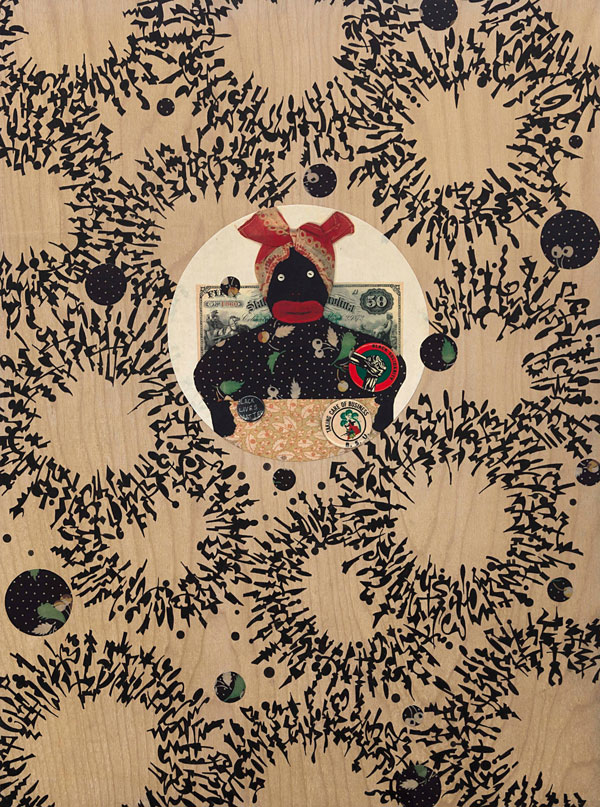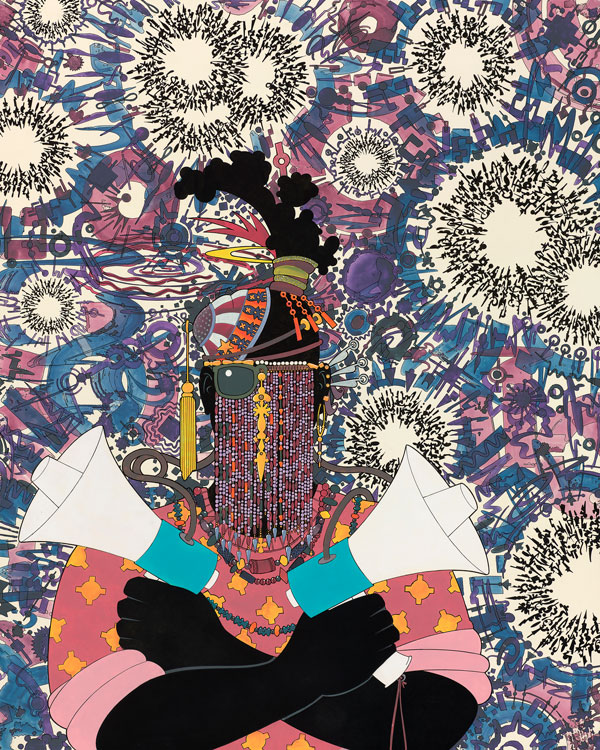Mark Steven Greenfield’s works explore the complexities of the African American experience, speaking to personal as well as universal themes. While earlier works explored stereotypes characterized by black cartoon characters and Blackface minstrels, in his current exhibition, “Mantras & Musings,” he uses the spiritual practices related to Egungun (Yoruba masquerades or costumed figures) as a point of departure. Inspired by a residency in Brazil, the works depict contemporary Egungun, amalgamations of past and present, good and evil, positive and negative energies often enmeshed in a field of abstract calligraphy that becomes a pattern behind the figure.
Greenfield frequently juxtaposes images drawn from current events—a shooting in Florida, or Charlotte—with geometric patterns, as in The Charlotte Observer (2017), where a beaded headdress masks the face of a sunglass-wearing dark-skinned figure holding a megaphone in each hand. Drawing from disparate sources and cultures, Greenfield presents an image of a powerful God-like figure surrounded by colorful, ornate and delicate patterns that appear like bursts of energy or complex microbes. In The Egun that Saved Florida (2014), amidst a field of white cotton flowers set against a nondescript background, a masked red-robed deity decorated with the expected beadwork patches unexpectedly holds a gun in a red-gloved hand.
Looking carefully at the patterned background in the ink jet print Crucilibum (2017), recognizable elements begin to emerge amongst the starbursts and cotton flowers; for example, Earth, sperm and myriad geometric shapes—but these are hardly the point. Greenfield contrasts this patterning with the presence of an anonymous headdress wearing figure in clothing depicting numerous boldly drawn hashtags.
In contrast, Greenfield also includes seemingly monochromatic compositions. These figureless works reference the growing and picking of cotton and Collard greens. From a distance, the ink-on-Duralar drawings appear to represent clusters of flowers or cells, but upon close examination the intricate nature of Greenfield’s mark-making becomes evident. Each cluster is comprised of interlinking black ink marks akin to automatic writing that articulate a compelling array of positive and negative space. The titles reference cotton, anchoring them in the trajectory of African American history.
While the larger color works are lush and captivating, illustrating the breadth of Greenfield’s skill, four small ink-on-wood panel pieces entitled On the Money (2016) directly speak to his position. Here, Greenfield juxtaposes his floral calligraphic marks with collaged circular fragments of Confederate money depicting African American workers. The etched lines of the printed documents fuse with the wood panels, paralleling Greenfield’s handwork and suggesting an endless circle of “this begets that.”
Moving back and forth between invented depictions of modernized Egungun to historical images from Confederate bills that depict seemingly complacent slaves, Greenfield gives pause and offers a space for contemplating the beauty of nature while simultaneously suggesting that through the process of making art it might be possible to momentarily transcend evil and injustice.



